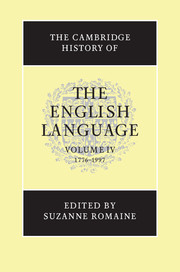3 - SYNTAX
Published online by Cambridge University Press: 28 March 2008
Summary
Introduction
Syntactic change
The topic of syntactic change in late Modern English is only just beginning to get its share of serious scholarly attention, and compared with the towers of published syntactic research which the Syntax chapters of volumes I–III in this series have been launched from, this chapter has had to rely rather more on its own bootstraps. All research surveys are by definition provisional, this one especially so.
By 1776 the English language had already undergone most of the syntactic changes which differentiate Present-Day English (henceforth PDE) from Old English (henceforth OE) (see CHEL I: 170–1). Older patterns of word order with the verb at the clause end or in second constituent position had long been replaced by an unmarked order framed by the sequence subject–verb–object or subject–verb–complement. A subject noun phrase (NP) was virtually obligatory in simple clauses other than imperatives. Great simplifications had taken place in morphology, so that the noun and adjective had already reached their present, vestigial inflectional systems, and the verb nearly so. The number and frequency of prepositions had expanded greatly, and prepositions now served to mark a variety of nominal functions. Prepositions, particles and other words frequently joined simple lexical verbs to form group-verbs like speakto, makeup, takenotice of. Such formations as the prepositional and indirect passives had become commonplace. The complexity of the English auxiliary system had grown to encompass a wide range of mood and aspect marking, and much of its present systematic structure was already in place, including the dummy auxiliary do. Some patterns involving finite and nonfinite subordinate clauses had been rare or impossible in OE; by 1776 most of the present repertoire was available.
- Type
- Chapter
- Information
- The Cambridge History of the English Language , pp. 92 - 329Publisher: Cambridge University PressPrint publication year: 1999
References
- 19
- Cited by



